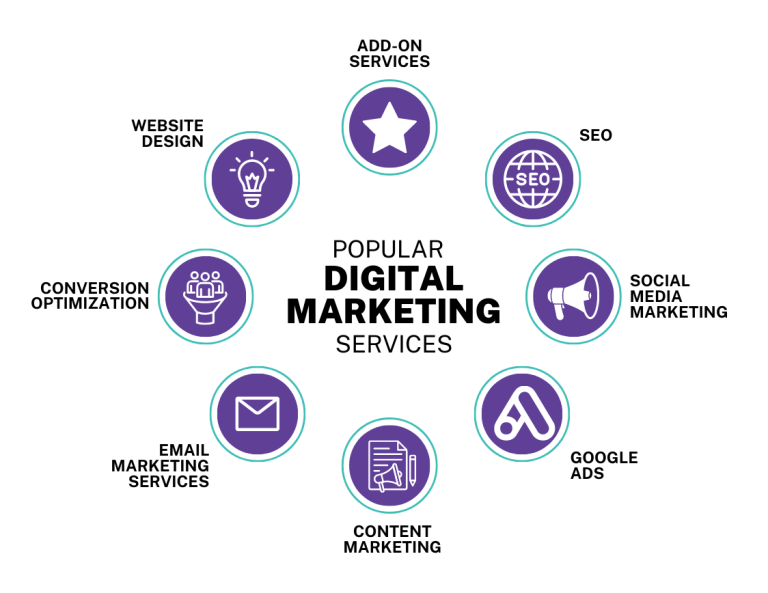What digital marketing services do you offer?

We offer a comprehensive suite of digital marketing services tailored to meet your specific goals. These include Search Engine Optimization (SEO) to improve your website’s ranking in search results, Pay-Per-Click (PPC) advertising for instant traffic, and Social Media Marketing to engage and grow your audience on platforms like Facebook, Instagram, and LinkedIn. We also provide Email Marketing for nurturing leads, Content Marketing to position you as an industry expert, and Website Design & Optimization to ensure your site is fast, mobile-friendly, and conversion-focused. Our team works with you to create a cohesive strategy that drives measurable growth.
As an expert in digital marketing, I can outline the comprehensive suite of services typically offered to help businesses thrive in the online landscape, along with a strategic roadmap for their implementation. Digital marketing agencies specialize in connecting businesses with their target audiences through various digital channels, moving beyond just having a website to actively engaging and converting prospects.
Digital Marketing Services Offered
Digital marketing agencies provide a diverse array of services, tailored to meet specific business goals and target audience needs. These services are designed to increase brand visibility, drive engagement, generate leads, and ultimately boost sales or achieve other defined objectives.
Here are the key services:
- Search Engine Optimization (SEO): This service focuses on improving a website’s visibility and ranking in organic (unpaid) search engine results like Google.
- Keyword Research: Identifying the terms and phrases potential customers use when searching for products or services.
- On-Page SEO: Optimizing individual web pages, including refining meta tags, headings, and content, to rank higher and attract relevant traffic.
- Technical SEO: Ensuring the website meets search engine technical requirements, such as improving site speed, mobile-friendliness, and proper indexing.
- Link Building: Acquiring high-quality backlinks from other reputable websites to enhance domain authority.
- Pay-Per-Click (PPC) Advertising: This is a form of paid advertising where businesses pay a fee each time their ad is clicked, allowing for quick traffic generation.
- Google Ads: Targeting users actively searching for related products or services on Google.
- Social Media Ads: Reaching specific demographics based on interests and behaviors on platforms like Facebook.
- Campaign Management: Meticulously researching keywords, crafting compelling ad copy, designing engaging landing pages, and optimizing bidding strategies to maximize click-through rates and conversions.
- ROI Measurement: Continuously measuring the return on investment to ensure effective ad spend.
- Social Media Marketing (SMM): This involves leveraging social media platforms to promote products or services, build brand awareness, and engage with audiences.
- Organic Social Media Management: Curating content calendars, creating captivating posts, scheduling, and community management to build a loyal following and foster engagement.
- Paid Social Media Advertising: Utilizing paid campaigns to boost brand visibility and reach specific demographics and interests.
- Content Marketing: This service focuses on creating and distributing valuable, relevant, and consistent content to attract and retain a clearly defined audience.[1, 5, 2, 4]
- Blog Posts: Providing valuable information to attract and engage readers, establishing the brand as a thought leader.
- Video Production: Capturing attention with compelling visual content that conveys messages quickly and effectively.
- Infographics: Using visuals to simplify complex information and make it more digestible.
- Content Strategy: Developing comprehensive content plans that align with brand identity and goals, including research into industry trends and target audience preferences.
- Email Marketing: This involves sending targeted emails to prospects and customers to nurture leads, build relationships, and drive conversions.
- Newsletters: Keeping the audience informed with regular updates, company news, and promotions.
- Lead Nurturing: Guiding prospects through the sales funnel with targeted, personalized emails.
- Automation: Streamlining email campaigns to deliver timely messages and responses based on subscriber actions.
- List Segmentation: Segmenting email lists to ensure messages are tailored to recipients’ interests and behaviors, increasing open and click-through rates.
- Influencer Marketing: Partnering with influential individuals to promote a brand or product to their established audience.
- This involves recruiting suitable influencers, evaluating their capabilities, negotiating terms, and providing promotional materials and tracking links.
- Branding and Graphic Design: Creating and maintaining a consistent visual identity and brand message across all digital touchpoints.
- This includes logo design, color schemes, brand guidelines, and various graphic assets.
- Web Design and Development: Creating and optimizing websites that serve as the central hub for digital marketing efforts.
- This can range from basic business websites to complex e-commerce platforms, including ongoing maintenance and support.
- Conversion Rate Optimization (CRO): Enhancing a website’s efficiency to convert visitors into leads or customers.
- This involves analyzing user behavior and making data-driven adjustments to improve conversion rates on landing pages and other web assets.
- Affiliate Marketing: A performance-based marketing strategy where businesses reward affiliates for each customer brought by the affiliate’s own marketing efforts.
Step-by-Step Roadmap for Digital Marketing Services
A successful digital marketing engagement follows a structured, strategic roadmap to ensure alignment with business objectives and measurable results.
Step 1: Define Your Business Goals and Objectives The foundational step is to clearly articulate what you want to achieve. These goals should be SMART: Specific, Measurable, Attainable, Relevant, and Time-bound. Examples include increasing website traffic by a certain percentage, generating a specific number of leads, or boosting online sales within a defined period.
Step 2: Conduct Thorough Market Research and Audience Analysis Understanding your target audience is paramount. This involves creating detailed buyer personas based on demographics, psychographics, pain points, and online behavior. Simultaneously, a comprehensive analysis of your competitors helps identify market trends, opportunities, and gaps.
Step 3: Audit Your Current Digital Presence Evaluate your existing digital assets, including your website, social media profiles, and content. This audit identifies strengths, weaknesses, opportunities, and threats (SWOT analysis) and provides a baseline for future efforts. It also involves gathering historical data on past spending, performance, and channel effectiveness.
Step 4: Develop a Comprehensive Digital Marketing Strategy Based on the insights from the previous steps, a tailored strategy is developed. This involves:
- Channel Selection: Choosing the most effective digital channels (e.g., SEO, PPC, social media, content, email) that align with your goals and target audience.
- Content Strategy: Planning the types of content to create, topics to cover, and frequency of publication.
- Messaging and Brand Voice: Defining how your brand will communicate across all platforms.
- Customer Journey Mapping: Outlining how potential customers will move from awareness to conversion and retention. Frameworks like RACE (Reach, Act, Convert, Engage) or the Flywheel (Attract, Engage, Delight) are often used to guide this process, ensuring a 360-degree perspective. The STP (Segmentation, Targeting, Positioning) model helps in refining audience focus and messaging.
Step 5: Allocate Budget and Resources Determine a realistic budget based on the chosen strategies and services. This includes allocating funds for agency fees, ad spend for paid campaigns, and any necessary tools or software. Decisions are made regarding in-house execution versus outsourcing (e.g., leveraging white-label services for scalability).
Step 6: Implement Campaigns and Execute Tactics This is the execution phase where the planned strategies are put into action. This includes:
- Optimizing your website for search engines.
- Creating and distributing content.
- Setting up and managing paid advertising campaigns.
- Managing social media presence and engagement.
- Launching email marketing sequences.
- Implementing tracking tools like Google Analytics to monitor performance from the outset.
Step 7: Monitor, Analyze, and Optimize Continuously Digital marketing is an iterative process. Establish Key Performance Indicators (KPIs) that directly align with your goals (e.g., conversion rates, cost per lead, customer lifetime value). Regularly review performance data using analytics tools, conduct A/B testing, and be prepared to adjust strategies, reallocate funds, or refine tactics based on insights. This continuous cycle of monitoring and optimization is crucial for maximizing ROI and achieving long-term success.

